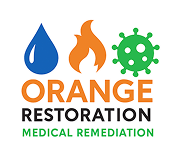Fire Damage is a long process and Orange Restoration gives you an overview of procedures and processes to help you restore fire damage and repair your property and assets.
Fire Damage can happen at any time. Once the fire trucks are gone, your journey is just beginning. That’s because your home almost certainly suffered smoke and fire damage as well as possible water damage. But the professionals at Orange Restoration have the skills and equipment necessary to restore your house to the way it was before the fire.
All fire damage restoration is different and every home requires its own specific approach, but the following is the general process we follow in a typical fire damage restoration situation:
- • Emergency response. When you make your call to us, the restoration process begins. Our customer service representative will ask the right questions so that we can respond quickly and bring along the right resources and equipment.
- • Inspection and assessment. We inspect the impacted area and adjoining rooms to find out the extent of the soot, smoke and other fire damage, then we can develop our plan of action.
- • Securing the structure. Preventing further damage is essential, so we take immediate action to board up broken windows, shore up damaged walls and put tarps over damaged sections of the roof.
- • Water removal. When water damage is present, we immediately start water removal. Dehumidifiers and air movers are used to get all the water from your home and complete the drying process.
- • Surface soot and smoke removal. Using special equipment and time-tested techniques, we get rid of soot and smoke from the ceiling, all walls and other hard surfaces.
- • Cleaning and disinfecting. Restorable items require cleaning and sanitizing. A variety of cleaning products and techniques are used to accomplish this as appropriate. This process includes odor removal using foggers and industrial-strength air scrubbers.
- • Restoration. Getting things back to normal is the final step in the process. This can involve small repairs, drywall replacement, new carpet installation, painting and more. Major construction may sometimes also be required.
Improving Indoor Air Quality After a Fire
Even after visible damage is cleaned, the air inside a fire-damaged property can remain hazardous. Microscopic soot particles and volatile organic compounds (VOCs) from burned materials can linger in the air, embedding in porous surfaces and HVAC systems. These contaminants not only affect air quality but can also trigger respiratory irritation or worsen conditions like asthma and allergies.
To address this, advanced air filtration and purification are essential. Professional restorers use HEPA-filtered air scrubbers, negative air machines, and sometimes hydroxyl or ozone treatments (depending on the situation) to remove airborne particulates and neutralize odors. Monitoring air quality throughout the process ensures that the indoor environment is truly safe for re-entry and long-term occupancy.
Finishing the Fire Damage Repairs
Recovering from fire damage takes time, precision, and a clear understanding of each phase in the process. From the first inspection to the final coat of paint, every step plays a role in bringing a home or business back to stability and comfort. While no two restoration projects are ever the same, a well-structured approach ensures that the damage is properly addressed and that the space can once again feel safe, functional, and familiar.
